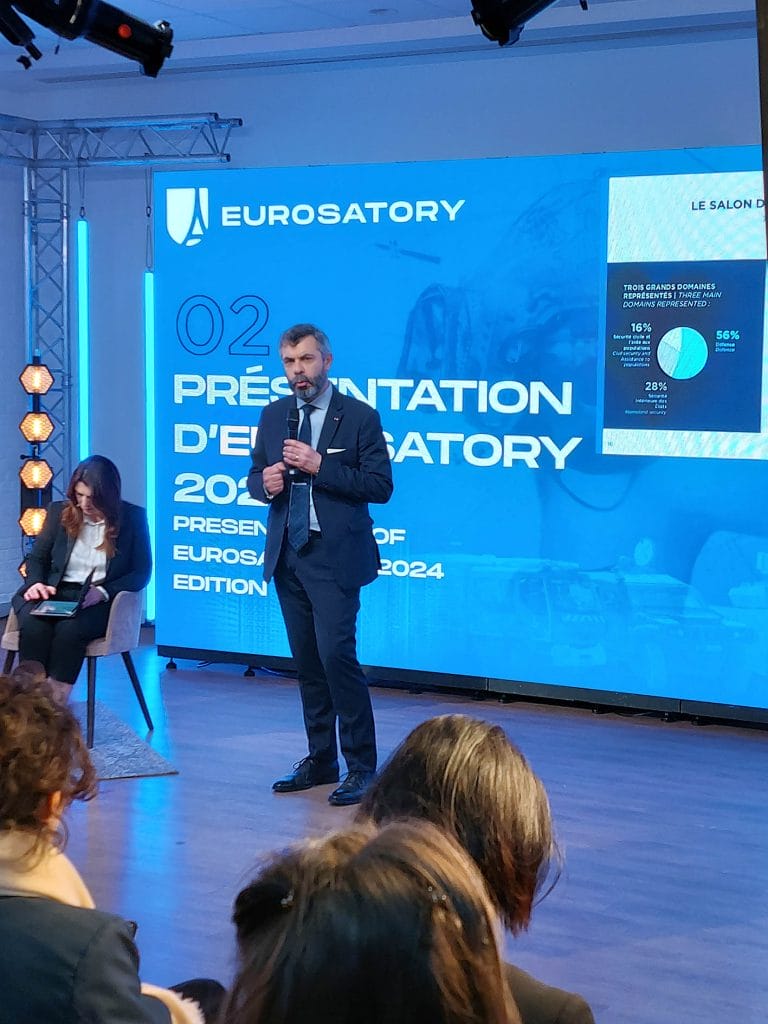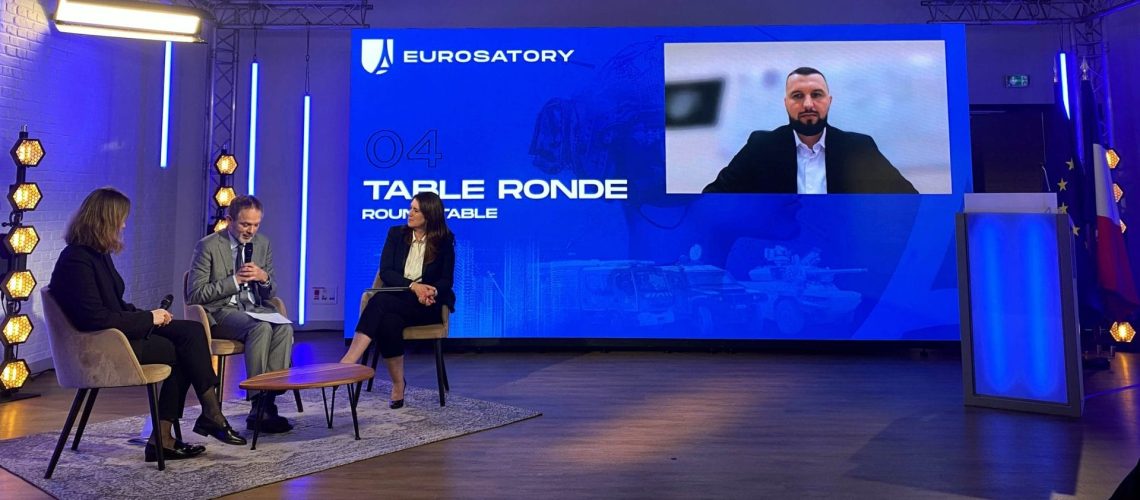Photo: Ihor Bezkaravainy, Ukraine’s Deputy Minister for Economic Affairs, in charge of mine clearance speaks at the March 19th Eurosatory Press conference © Coges
Synthesis of the Eurosatory press conference held on March 19, 2024
Following a presentation by Marc Darmon, President of GICAT, and General (Ret.) Charles Beaudouin, General Commissioner of Eurosatory, this press conference, moderated by Emmanuelle Dancourt, gathered two researchers, Amélie Férey from IFRI and Jean-François Ripoche from EDA. This was followed by a presentation by Ihor Bezkaravainy, Ukraine’s Deputy Minister of the Economy, in charge of mine clearance, and a Q&A session.
I. The context of Eurosatory 2024 Edition
Marc Darmon, President of GICAT, began by highlighting the very special context in which the Eurosatory exhibition will be held this year, marked by the return of war on the European continent: ” crises and conflicts overlap rather than replace each other “, as we are facing an unprecedented mix of high-intensity conflicts, terrorist risks, cyber threats and environmental crises. Reflecting these upheavals, global military spending continues to rise, with an estimated 9% increase between 2022 and 2023 to reach $2,200 billion.
European countries have participated in this growth, and have launched a number of initiatives in response to the war in Ukraine, designed not only to meet the need for munitions (ASAP for ” Act in Support of Ammunition Production “), but also to encourage EU member states to strengthen their intra-European procurement procedures in order to be able to acquire up to 50% of their equipment budgets from Europe by 2030 (EDIRPA for ” European defence industry reinforcement through common procurement act “and EDIP for ” European Defence Industry Programme “).
He highlighted the fact that France, now the world’s second largest arms exporter, relies on a defense industry that has demonstrated its resilience and ability to adapt to new realities on the ground. The shift to a war economy announced by President Macron at Eurosatory is beginning to bear fruit, with faster manufacturing cycles and higher production rates in a number of sectors (Caesar howitzer and Mistral missiles in particular).
For General (Ret.) Beaudouin, the new era is characterized by five megatrends – geopolitical, economic, societal, environmental and technological -, and is forcing public and private players in the defense and security sector to face a number of challenges, including ” assess one’s sovereignty “by encouraging a policy of ” reindustrialization based on chosen rather than imposed dependencies ”.
Eurosatory is thus firmly positioned as the “show of all crises“, with a range of defense, homeland security and civil protection solutions unrivalled anywhere in the world (1,600 exhibitors to date, of which only 17% offer lethal solutions). He concluded his introduction with the following words: ” new world, new challenges, new solutions. If you come to Eurosatory, you’ll find what you’re looking for, but also what you didn’t know you were looking for… ” He also underlined the ambition of Eurosatory, with its hundred or so conferences, to ” take on new subjects “, such as the one discussed in the second part of this press conference.

Photo: presentation by General (Ret.) Beaudouin © Coges
II. New conflictualities and the environment: to what extent do legitimate forces integrate the environmental dimension of conflicts to support a sustainable peace?
For Amélie Férey, there are a number of European initiatives aimed at limiting the use of ecocidal weapons before conflicts occur, whether by mapping problematic weapons systems or promoting efforts to develop standardized materials and ammunition (e.g.: 2006 Directive Research “. At the national level, the application by the French procurement agency (DGA) of the principle of eco-design to weapons production in France is also an existing focus before conflicts arise.
Once a conflict occurs, the prohibition of the use of particularly environmentally destructive weapons, such as depleted uranium ammunition and white phosphorus, is already in place.
Finally, post-bellum battlefield clean-up already exists in some areas, such as mine clearance. In this respect, Jean-Francois Ripoche notes that artificial intelligence could prove particularly useful for both locating and planning that type of mine clearance operations.
He also believes that another form of environmental awareness has been taking place among the European Union members, through strategies increasingly put in place by their armed forces to promote sustainable energies and circular economy, which encourages the recycling of several types of equipment. A deployable camp initiative with the smallest possible logistical footprint, for example, has brought together nine European ministries of defense over the past few years (editor’s note: INDY stands for energy independent and efficient deployable military camps “).
III. Mine clearance in Ukraine: “Winning the battle against mines”
For Ihor Bezkaravainy, Ukraine’s Deputy Minister of the Economy, in charge of mine clearance, his country is ” at the epicenter of nature’s destruction “, as Russia has contaminated the soil and caused enormous damage through deliberate destruction, such as at the Karkhovka dam.
Kiev’s first objective in relation to ecocide crimes is to document them as accurately as possible, and to ensure that the criminals are prosecuted internationally. For the vice-minister, “bringing the crime of ecocide into international law ” goes hand in hand with supporting economic recovery while respecting environmental best practice. One power point slide presented by the vice-minister shows losses of 56.7 billion euros and over 3,300 documented cases of environmental damage.
One of the difficulties in collecting data is controlling its quality, but a digital application can at least inform people about dangerous or potentially contaminated areas to avoid.
The keystone of this approach is, of course, the question of mine clearance, with 30% of the country contaminated by mines and munitions (according to another power point slide displayed during the presentation, 174,000 m2 could be ” potentially contaminated by mines and explosive devices ” – 2023 figures).
A study is currently underway to try and identify priorities in terms of mine clearance, while at the same time measuring the impact on the environment and on populations, via the analysis of soil quality, water levels, carbon capture, etc…
The requirements in this area include not only equipment, but also the right quantity of trained personnel and support services, including the ability to manufacture spare parts on site. “It’s a multifaceted problem “, mixing military and economic aspects.
The Vice-Minister concluded his presentation by expressing his support for a ” fair peace “, but also for the inclusion of ecocide crimes in the list of international crimes. We need to work together on a definition to prevent such acts from happening again.
Concluding this press conference, which was attended by more than two hundred participants online, General (Ret.) Beaudouin praised the courage of the Ukrainians and the strength which brings them the drive and ” the means to “win the battle of the mines” “. Ihor Bezkaravainy concluded that ” war is an experience “, ” a tragedy that brings with it lessons” that it is imperative to share …
